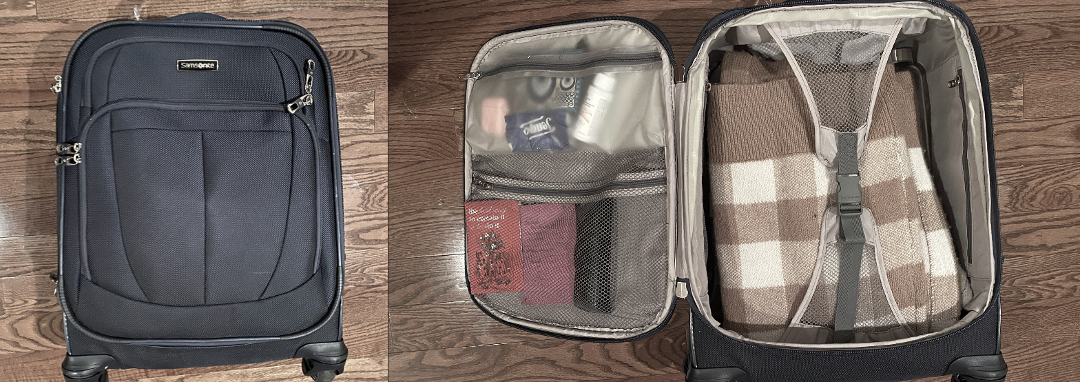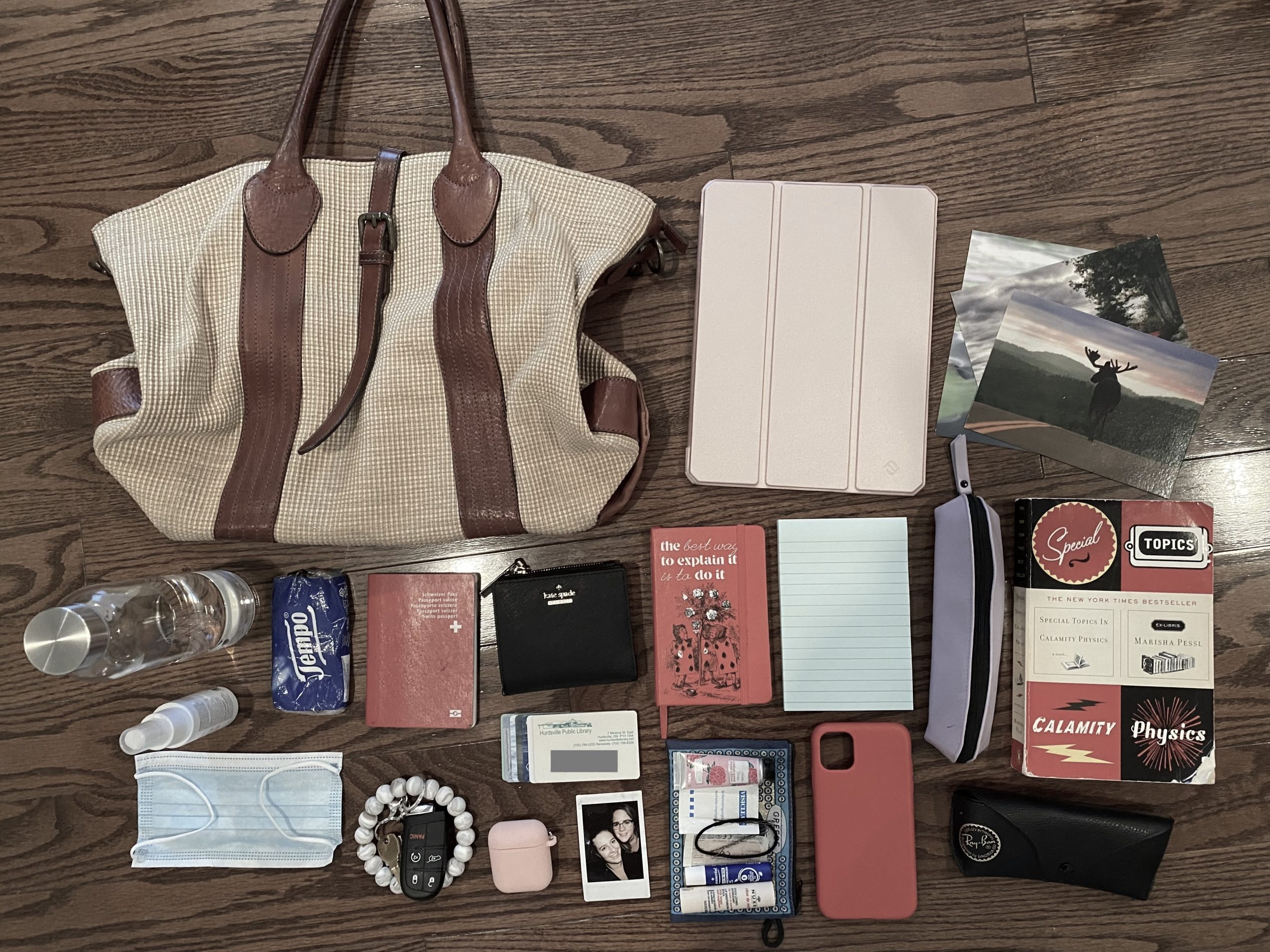Mode bending

Find my original task here.
Access my updated task here!
Original task:
 When completing Task 1, my focus was mostly on sharing the contents of my bag and identifying the different text technologies found therein. Looking back, my priority was not how I shared the contents of my bag (one picture), but the analysis itself.
When completing Task 1, my focus was mostly on sharing the contents of my bag and identifying the different text technologies found therein. Looking back, my priority was not how I shared the contents of my bag (one picture), but the analysis itself.
Through this activity, I identified some of the assumptions viewers might make about the owner of these objects. However, I think my analysis was quite broad as I identified things such as nationality, my love of reading, etc., rather than reflecting on the more specific assumptions that could be made about my background and experiences. As mentioned in Task 1, I used to really enjoy getting a glimpse of ‘What’s in my bag’ in the back of some magazines, but I think that I did not realise the more specific assumptions we can make about the owners of the bags and their age, education, income, race, etc.
Mode bending:
For this task, I wanted to reimagine the way I shared the contents of my bag to make it more engaging for the viewers. This task was done with my peers and professor being the intended viewers, but it is something I can consider when planning lessons for my students. In their video, Puentedura states how, as teachers, we need to persistently re-examine our practice to ensure that we are using technology in the best way (Common Sense Education, 2016). Cazden et al. (1996) similarly encourage the re-evaluation and evolution of our practice. One way to do this is by looking at the Substitution Augmentation Modification Redefinition (SAMR) model to improve our practice by doing what the name suggests: substituting, augmenting, modifying, and redefining (Common Sense Education, 2016). Cazden et al. (1996) propose considering “six design elements in the meaning-making process: those of Linguistic Meaning, Visual Meaning, Audio Meaning, Gestural Meaning, Spatial Meaning, and the Multimodal patterns of meaning that relate the first five modes of meaning to each other” (p. 65). From the moment of original design to the evaluation and redesigning of the lessons, there is always a multitude of things to consider in order to make the content more relatable. Cazden et al. (1996) recommend multiple modes of meaning on top of linguistic, such as visual, audio, gestural, spatial, and multimodal (p. 80). When redesigning my task, I wanted to take this into consideration and develop my means of expression.
 At first, I thought about creating a video as I have used iMovie in the past, but then I felt I wanted to create something interactive. If one was to look into someone else’s bag, they would be able to open the pockets and different compartments. Not only see what objects are inside, but how they are organized and grouped. On top of this, I wanted to incorporate images, text, and audio. This way, if someone leaned more towards audio, they could listen to the audio, but if someone preferred reading, they could read, or even do both. In the same sense, the viewer could choose to ignore the audio and text and just make their own observations about the objects they could find in the pictures. By clicking on the different buttons, the viewer could explore what they wanted or return to previous pictures.
At first, I thought about creating a video as I have used iMovie in the past, but then I felt I wanted to create something interactive. If one was to look into someone else’s bag, they would be able to open the pockets and different compartments. Not only see what objects are inside, but how they are organized and grouped. On top of this, I wanted to incorporate images, text, and audio. This way, if someone leaned more towards audio, they could listen to the audio, but if someone preferred reading, they could read, or even do both. In the same sense, the viewer could choose to ignore the audio and text and just make their own observations about the objects they could find in the pictures. By clicking on the different buttons, the viewer could explore what they wanted or return to previous pictures.
Benefits of mode bending:
As the SAMR model recommends, teachers need to evaluate and re-evaluate their teaching strategies (Common Sense Education, 2016) not only to encourage productiveness and positive learning environments through relevant learning opportunities (Cazden et al. 1996), but also to extend the learning they have already developed by living in a technological world (Dobson & Wilinsky, 2009). Thanks to the development of technology, we have access to innumerable amounts of documents, indexes, and databases on every theme imaginable spanning over centuries (Dobson & Wilinsky, 2009). Granted, having this kind of access is unique to a technologically developed society, but access to written works is not what is unique; our ability to communicate, share, debate, question, and work with peers around the world in an instant is (Dobson & Wilinksy, 2009). This environment is conducive to rapidly evolving technologies and information, so it would be natural that our means of teaching would also need to evolve alongside them. According to Cazden et al. (1996), multiliteracies “overcomes the limitations of traditional approaches by emphasizing how negotiating the multiple linguistic and cultural differences in our society is central to the pragmatics of the working, civic, and private lives of students” (p. 60). A multiliteracies pedagogical approach allows for a broader representation when it comes to language, culture, and social differences (Cazden et al., 1996).
Through this mode bending activity and looking at the SAMR model, I was able to modify a simple picture into a more interactive activity including audio, text, and a few more pictures. After completing this activity, I can re-evaluate and consider ways in which I could redefine this activity to increase attention and performance.
Challenges of mode bending:
One of the challenges that comes with mode bending is that technology is rapidly evolving. Something that may be new to an educator could be something quite natural in their students’ lives. As we grew up in different generations, we “most likely do not share the same learning styles as [our] students” (Mabrito & Medley, 2008, para. 4), but perhaps even our colleagues. It is possible that students interact with new information in a completely different way than their teachers (Mabrito & Medley, 2008). This can be a challenge for instructors that are trying to develop learning opportunities while trying to learn about new technologies themselves.
It would be good to keep in mind that advances in technology do not make previous technologies irrelevant. There are benefits to embracing older technologies as we move forward. For example, although online texts offer hypertexts, print offers footnotes and options for physical interaction with the materials being used (Dobson & Wilinsky). At times we may be so focused on incorporating modern technology that we forget the basics or overlook how to discern the appropriate modifications. “Good technology integration isn’t about using the fanciest tool, it’s about being aware of the range of options and picking the right strategy – or strategies – for the lesson at hand” (Terada, 2020, para. 1).
When it comes to developments in technology, it is also worth keeping note of who may have access to those advances in technology. For example, “the likelihood of someone in a high-income country being a regular Internet user [is] 22 times greater than in a low-income country (Dobson & Wilinsky, 2009, p. 13). Geography is to be considered, but also age, gender, education, income, etc. It is one thing to determine the access of a small group of students, but it can become more challenging when it comes to larger audiences. Offering an array of learning opportunities and using different elements in the meaning-making process is a good place to start (Cazden et al., 1996).
Moving forward:
Now, I can see some more specific conclusions that might be made about me as the owner of this bag. Reflecting on this mode bending task, I see ways that I could change this activity using the SAMR model (Common Sense Education, 2016). This way, focus could be put more directly on the objectives of what I want the viewers to achieve. For example, find out what kinds of conclusions they draw about the owner of this bag and, perhaps get the opportunity to share their own project. The internet offers a vast number of collaborative platforms where students can create and share their projects. I originally was looking at ThingLink for my project, but after exploring the website, I felt that Genially offered better options for what I wanted to create. I am glad I tried them out because I had not used them before and “We need to experience these learning spaces as learners before we can understand how to use them as teachers” (Mabrito & Medley, 2008, para. 16).
If I were to attempt this task a third time, I would try to incorporate different modes of meaning (Cazden et al., 1996). For example, I could add in questions, polls or a discussion to encourage interaction. It would also be fun to incorporate video or find ways to include spatial meanings somehow. Perhaps a video of the items, the bag, and then the packing up of the bag, or the different places where the items in the bag are used.
References
Cazden, C., Cope, B., Kalantzis, M., Luke, A., Luke, C., Nakata, M., & New London Group (1996). A pedagogy of multiliteracies: Designing social futures. Harvard Educational Review, 66(1), pp. 60-92. https://doi.org/10.17763/haer.66.1.17370n67v22j160u
Common Sense Education (2016, July 12). How to apply the SAMR model with Ruben Puentedura [Video]. YouTube. https://www.youtube.com/watch?v=ZQTx2UQQvbU
Dobson, T.M., & Willinksy, J. (2009). Digital literacy. In D. R. Olson, & N. Torrance, The Cambridge handbook of literacy (pp. 286-312). Cambridge University Press.
Mabrito, M., & Medley, R. (2008). Why professor Johnny can’t read: Understanding the net generation’s texts. Innovate: Journal of Online Education, 4(6).
Terada, Y. (2020, May 4). A powerful model for understanding good tech integration. Edutopia. https://www.edutopia.org/article/powerful-model-understanding-good-tech-integration